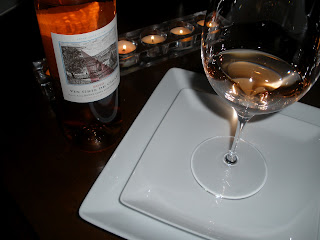My menu plan was to start out with three light bites, but with bold flavors that prepare us for a powerful main course. We started the meal with a beautiful cucumber canapé. English cucumber sliced on the bias with a lobster salad placed delicately on top. Next came another canapé, but this time on little pieces of toast we cut from the bread we made (using our basic bread base) topped with Brie, honey and a berry reduction. Our final light bite was also a canapé, this time using mozzarella, eggplant and a balsamic reduction. All three were amazing!
The one ingredient I couldn’t find on short notice was honey with real honey comb, so if anyone out there has a friend with bee hives let me know. I like the texture and the presentation of the honey comb on top of the Brie. I also think a homemade cracker would pair nicely if you don’t want to use toast.
Now for the main course, the idea here is to create a steak and lobster dinner that is presented in a more modern style. The basic flavors and cooking methods for all of the items was the same, this dish is all about the presentation and I think they did a great job. The plate is dressed with an incredible port wine reduction, followed by mashed potatoes upon which the steak medallions are placed and finished with a two portions of diced lobster.
We concluded with meal with my rich, dense, and moist brownie prepared in four inch rounds. Peanuts and cashews were added for a nice flavor and texture addition. And you can’t have a brownie without vanilla ice cream.
Lobster Canapé: English cucumber partially peeled and sliced on the bias, lobster, jalapeño, mango, red onion with a cilantro garnish. (Left)
Brie Canapé: Toast round, Brie cheese, honey (or honey comb), berry reduction and garnished with mint chiffonade. (Right)
Eggplant Canapé: Toast round, mozzarella cheese, broiled eggplant, tomatoes, finished with balsamic reduction and parsley garnish. (Left)
Steak and Lobster: Butter poached lobster; filet mignon medallions over mash potatoes finished with a port wine reduction sauce. I would plan on one medallion per plate rather than the two shown. (Right)
Dessert: The cashew and peanut brownie was prepared using four inch spring pans to create an individual dessert portion and uniformity in the presentation. This is a dense moist dark chocolate creation that can also be prepared in a traditional baking pan. Served with vanilla ice cream and is it okay to garnish it with a little mint, but I prefer some chopped nuts.
Beverages: The appetizer courses needed a wine that would hold up to the cheeses, pair well with the earthiness of the eggplant, and not over-power the lobster. The choice was a bright lees aged New Zealand Chardonnay from Stone Bridge. David Hart and his wife are producing a bright but complex Chardonnay that is barrel aged on the lees (that's the yeast) creating a wonderful full -bodied white wine; perfect for our unique progression of appetizers. This wine could have been carried over to our main-course, but I had a special wine already in mind. After reviewing Arbor Crest's Dionysus Meritage earlier this week and in celebration my recent publication, it was only appropriate to share this Washington treasure. For dessert we went with a Heitz Cellar Ink Grade Port; a perfect ending to a good meal with great company.
Wine Suggestions -
Appetizers: Any medium to full-bodied white that is fermented dry (meaning there is no residual sugar left) would pair well. A Viognier, Pinot Gris/Grigio, or Meritage would be nice. A Sauvignon Blanc or other high acid and minerally wines may taste bitter when paired with these items. If you want to go red, pick a medium bodied wine that is on the lighter side of 12.5% alcohol, but still fermented dry. No heavy tannins, overly oak, or bold wines should be selected; think for fruit forward light and jammy. A Gamy, or a youthful Malbec could work.
Entrée: Pairing to the steak with lobster is really dictated by the port reduction sauce, which also contains Red wine (Cabernet Sauvignon based). The rule is to follow the sauce, then the main protein, so in this case the ideal wine would be a Cabernet Sauvignon based wine - our selection was the Meritage. Other reds that would pair well would be a Carmenère from Chile. Traditional reds such as Merlot, Syrah, or a Tempranillo would also complement the meal nicely.
Dessert: The rich chocolate comes to life with a Port, as we did tonight, but also other traditional dessert style wines can be enjoyed. Sauternes' wines of Bordeaux France would be a treat; Ice Wine/Eiswein, Late harvest Riesling or Gewürztraminer would also pair well.
For my complete recipes click on the links below:
Lobster Canapé Brie Canapé Eggplant Canapé Filet Mignon
Mashed Potatoes Wine Reduction Sauce














